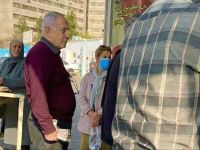It is not hard to find a book on Arab literature, art, cinema or even music. Online references are plentiful and sometimes comprehensive, while books ranging from academic studies to more easily accessible overviews can be picked up from any bookstore.
The same cannot be said for books on Arab theater.
The conventional stage play so well known in the West came relatively late to the Arab world, which had traditionally favored live storytelling performances or puppet shows. That said, theater has a distinguished regional history, which, despite its unique character and cultural significance, remains relatively undocumented.
The books that do exist, as Eyad Houssami points out in the introduction to his volume “Doomed by Hope: Essays on Arab Theatre,” are mostly sweeping regional surveys written by academics far removed from theatrical production and practice.
Houssami’s book is a welcome – if slightly haphazard – collection of short essays by playwrights, directors, academics and critics on Arab theater, featuring a foreword by Lebanese novelist Elias Khoury, who was involved in reviving the venerable Masrah Beirut in the wake of the Civil War.
Conceived and edited by Houssami, founding director of the Beirut-based theater collective Masrah Ensemble, the book assembles a wide range of ideas, performances and perspectives.
Published separately in English and Arabic, one of the book’s strengths is that it brings together perspectives from figures in the two theatrical spheres, making both accessible to readers of either language. Given that scripts written in Arabic are rarely translated into English, and the academic analysis of such texts may be written (and remain) in English, this is an unusual and valuable exercise.
Ostensibly, the essays in “Doomed by Hope” revolve around the work and legacy of Saadallah Wannous, the prolific Syrian playwright, who, before his death in 1997, spent decades fighting a cultural battle against censorship and authoritarianism.
In practice, however, the essays can be loosely divided into those focused on Wannous and those focused on contemporary regional theater production. These are in some cases linked to the Arab Spring and are for the most part written by dramatists and practitioners as well as academics.
While the latter group of texts can be linked to Wannous’ theatrical legacy, the connection is not always explicit and in many of the essays his name does not appear at all.
This is no bad thing, however, and as a result “Doomed by Hope” is more wide-ranging and inclusive than a focused tribute to Wannous – several of which have already been published – covering topics as diverse as Egyptian stage arts in the wake of the 2011 revolution, socio-political critique in Yemeni theater, theatrical practice in pre-Arab Spring Damascus, filmmaker Zeina Daccache’s first project working with prisoners in a Beirut prison, and Palestinian diaspora theater.
The essays on Wannous explore some of his most famous plays, among them “Soireé for the 5th of June” (1968), “The Elephant, The King of Time” (1969) and “Rape” (1990). Like the other essays in “Doomed by Hope,” these essays are written from a personal perspective and as such, even when the tone is academic, retain a conversational – even confessional – element.
Iraqi director and playwright Jawad al-Asadi, founder and director of Beirut’s Babel Theater, gives a particularly personal and poetic account of Wannous, a tribute to the playwright’s body of work, passion for theater and constant struggle for justice and freedom, along with an account of the two men’s friendship.
In conjunction with the launch of the book in Lebanon, the nonprofit collective Masrah Ensemble last month organized the “Doomed by Hope Theater Series,” which included readings of some of Wannous’ plays. The event also staged a performance of American writer and performer Jennifer Jajeh’s solo show “I Heart Hamas: And Other Things I’m Afraid to Tell You.”
In Houssami’s book, performance artist and scholar Joseph Shahadi analyses Jajeh’s work as an example of theatre in the Palestinian diaspora.
Jajeh’s “tragicomic” performance explores her experiences as a first-generation Palestinian-American. Sick of a lifetime of answering asinine questions about what being Palestine “means,” angry and hurt by having to justify her own existence, she decided to move to Ramallah – arriving just in time for the onset of the Second Intifada.
Jajeh has been performing “I Heart Hamas” in the U.S. for years and it made its U.K. debut at last year’s Edinburgh Fringe Festival. The chance to see Jajeh’s performance on stage provided an opportunity for Beirut audiences to form their own impressions of the work and to better evaluate and absorb Shahadi’s take on its significance as an example of a Palestinian theater created and performed beyond the reach of Israeli occupation.
The play is clearly written with a non-Palestinian audience in mind.
Among Jajeh’s minimal props is a board labelled “Ask a Palestinian,” which lights up periodically throughout the show, supposedly when enough audience members are thinking of the same question.
Jajeh then stops the performance to answer these telepathically communicated questions, which consist of a series of stereotypes and misperceptions of Palestinians – the kind of questions the actress has no doubt been asked many times in the past.
These questions – is Jajeh a terrorist, why doesn’t she have an “Arabic” first name, how can she be Christian and Palestinian, will she be belly-dancing – may work well when playing to a U.S. or European audience. In Lebanon, where some members of the audience were undoubtedly Palestinian and others knew better regardless, these techniques are less effective.
Jajeh’s performance boils down to her fear that she doesn’t fully belong in America or in Palestine and will always be an outsider. For many Palestinians living in Lebanon, this may not seem such a terrible position to be in. Indeed the remarks of several hecklers arising over the course of her performance provided simple answers to her soul-searching questions.
When Jajeh lamented the violence in Ramallah, asking: “Will things always be like this?” someone in the crowd shouted back “Yep,” provoking a wave of laughter.
At the end of her emotional closing speech, in which she describes herself as the break in a 450-year chain of her family’s life in Ramallah, she asks “Where does that leave me?” The same voice obligingly answered “America.” It detracted somewhat from the impact of her soliloquy.
Irrespective of how the show was received by individual Lebanese audience members, its performance here can be considered a success for Masrah Ensemble. Similarly, the “Doomed by Hope” project appears to be succeeding in its aim to bring together performers, productions and audiences from different backgrounds, giving them a much-needed chance to interact and overlap.
“Doomed by Hope: Essays on Arab Theatre,” edited by Eyad Houssami, is published in English by Pluto Press and in Arabic by Dar al-Adab. It is available in English and Arabic from Librairie Antoine and other local bookstores.








